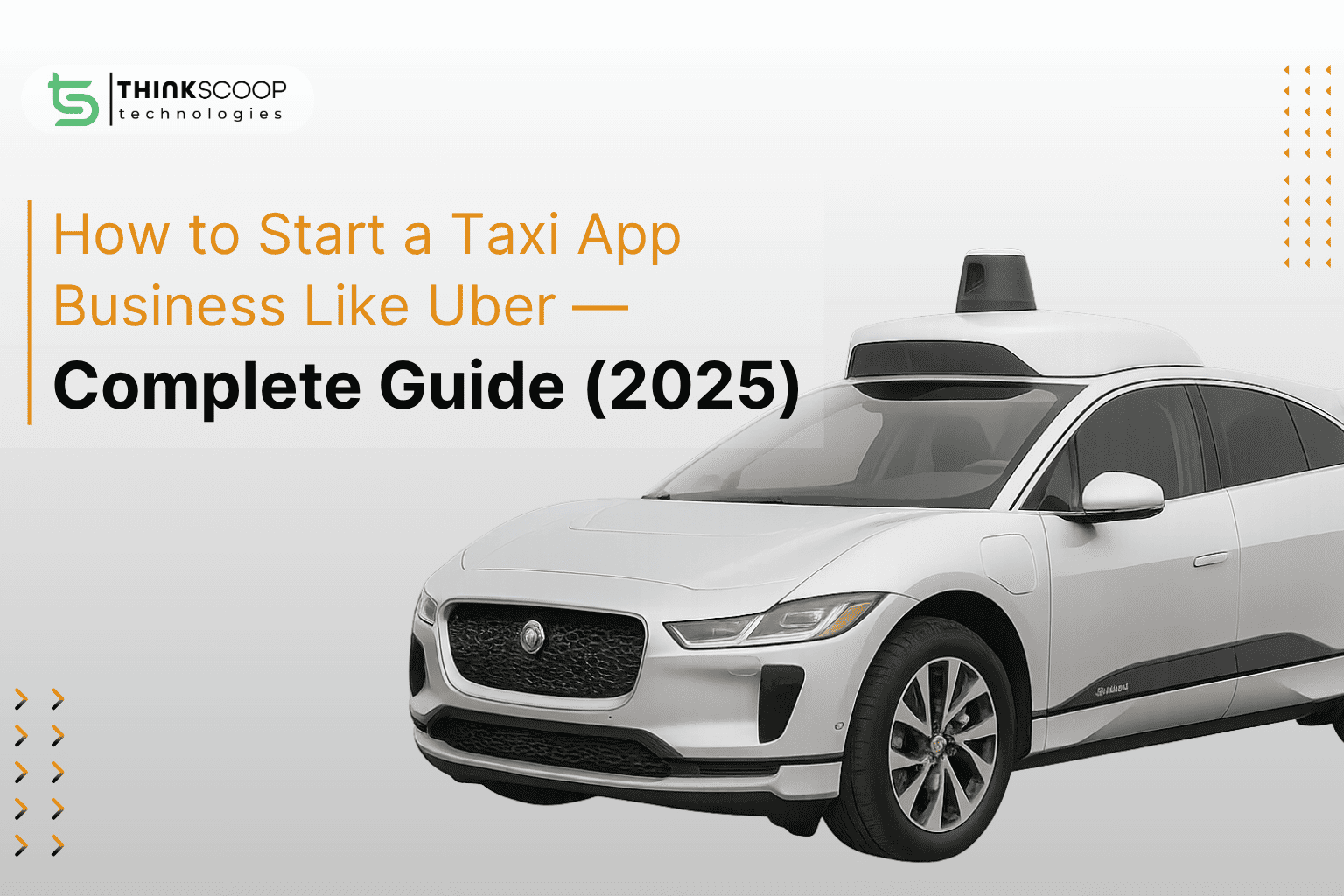Introduction
The global ride-hailing industry is thriving, with projections estimating it will reach over $400 billion by 2028. Apps like Uber, Ola, and Lyft have transformed how people move around cities, creating an incredible business opportunity for entrepreneurs. But launching your own taxi app business like Uber in 2025 is more than copying a model—it’s about identifying the gaps, solving real-world mobility problems, and scaling smartly.
In this in-depth guide, we’ll explore how to start a taxi app business like Uber, breaking down the entire journey from ideation and market research to app development, cost estimation, monetization models, go-to-market strategy, and operational scaling. Whether you’re a startup founder, investor, or an existing taxi business owner looking to digitize, this guide is tailored for you.
1. Understand the Market Landscape

Before diving into development, you need to understand the environment you’re entering.
Conduct Thorough Market Research:
- Target Demographics: Who are your riders? Are they office-goers, students, travelers, or late-night party-goers?
- Region Analysis: Choose cities with high population density, poor public transportation infrastructure, or high tourist influx.
- Behavior Trends: Do users prefer ride-hailing over traditional taxis? What are their pain points?
- Regulatory Environment: Check for legal requirements like driver background checks, vehicle permits, and insurance norms.
Pro Tip:
Don’t compete head-on with Uber in major cities right away. Instead, dominate smaller, underserved cities or niche categories like women-only taxis or electric vehicle fleets.
2. Choose the Right Taxi App Business Model
Your business model determines how you generate revenue and operate the platform.
Popular Models:
- Aggregator Model: Like Uber, connect riders with independent drivers and earn commission per ride.
- Ownership Model: Own your fleet and directly employ drivers. Higher control, higher investment.
- Franchise Model: Local entrepreneurs use your brand and tech platform for a fee.
- Hybrid Model: Mix of aggregator + franchise to scale flexibly.
Revenue Streams:
- Ride commissions (10–25%)
- Surge pricing during peak hours
- Monthly subscriptions for drivers (premium tools, analytics)
- In-app ads & brand sponsorships
- Premium ride categories (e.g., executive, luxury, EV)
- Driver onboarding fees
3. Key Features for a Taxi App Business
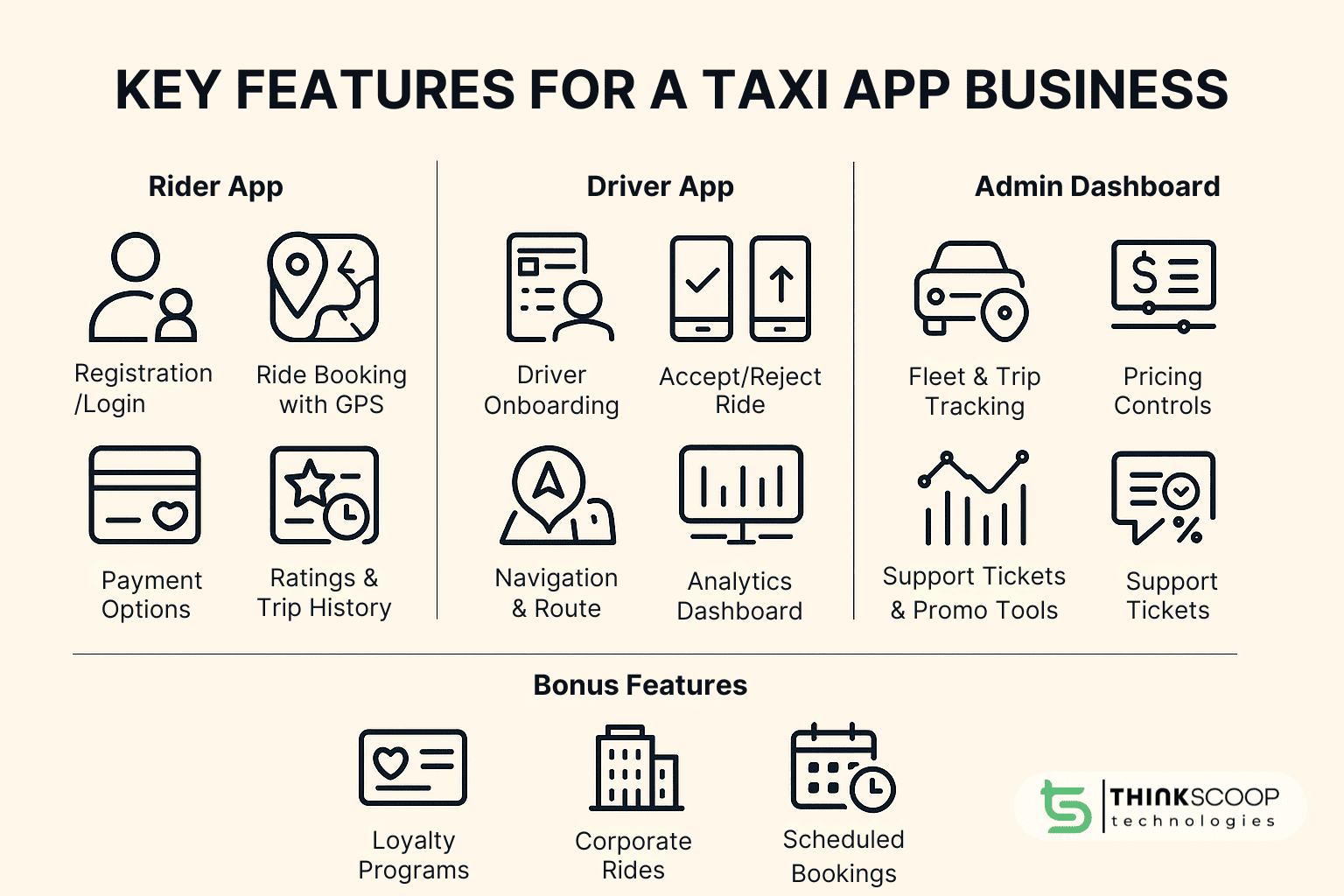
You need three main components: Rider App, Driver App, and Admin Dashboard.
Rider App:
- User registration/login (email, social media, OTP)
- GPS-based pickup & drop
- Fare calculator before ride confirmation
- Live driver tracking and ETA
- Ratings and feedback system
- Multiple payment options
- Emergency SOS & safety contact sharing
- Past trip history and e-invoices
Driver App:
- Driver registration and document uploads
- Accept/reject ride requests
- Navigation & route optimization
- Daily/weekly earning reports
- Wallet integration for payouts
- Ride history and user feedback
Admin Dashboard:
- Real-time tracking of fleet and trips
- Fare and surge pricing controls
- Driver verification management
- Complaint resolution and support tickets
- Revenue analytics and user behavior insights
- Promo codes and referral management
Bonus Features:
- Loyalty program for riders
- Corporate accounts
- Scheduled rides
- Driver incentive modules
4. Choose Between Custom Build vs White-Label Taxi App
Your choice depends on budget, timeline, and product vision.
| Option | Pros | Cons |
|---|---|---|
| Custom App | Fully customizable, scalable | Expensive, longer development |
| White-Label | Fast deployment, cost-efficient | Limited feature updates and branding |
At ThinkScoop, we offer both: plug-and-play Uber clone apps for quick launches, and custom-built platforms tailored for your exact needs, branding, and roadmap.
5. Ideal Tech Stack for a Taxi App
Frontend:
- React Native or Flutter (for Android & iOS)
Backend:
- Node.js with Express.js (fast and scalable)
Database:
- MongoDB (NoSQL flexibility)
- PostgreSQL (for complex relational data)
Real-Time Operations:
- Firebase
- Socket.IO
Mapping & Navigation:
- Google Maps API
- Mapbox (for lower-cost customizations)
Payment Gateways:
- Stripe
- Razorpay
- PayPal
Cloud Infrastructure:
- AWS EC2, Lambda, and S3 for scalability
- Firebase for notifications and analytics
6. Cost to Start a Taxi App Business in 2025
Here’s a realistic cost breakdown:
| Component | Estimated Cost |
| Rider App | $7,000 – $15,000 |
| Driver App | $6,000 – $12,000 |
| Admin Panel | $5,000 – $10,000 |
| Backend & API Dev | $8,000 – $15,000 |
| UI/UX Design | $3,000 – $6,000 |
| Testing & QA | $2,000 – $4,000 |
| Total Estimate | $30,000 – $60,000 |
Factors Influencing Cost:
- Number of features & platform versions (iOS, Android, Web)
- Choice of development model (in-house vs agency vs freelancers)
- Use of third-party integrations (chat, payment, geofencing)
7. Development Timeline
| Phase | Timeline |
| Research & Wireframing | 1–2 weeks |
| Design (UI/UX) | 2–3 weeks |
| Core Development | 8–10 weeks |
| Testing & Bug Fixes | 2–3 weeks |
| Pilot Launch | 1 week |
| Full Launch | After 12–14 weeks |
You can accelerate the timeline by using white-label solutions or pre-built modules.
8. Launch Strategy for Your Taxi App Business
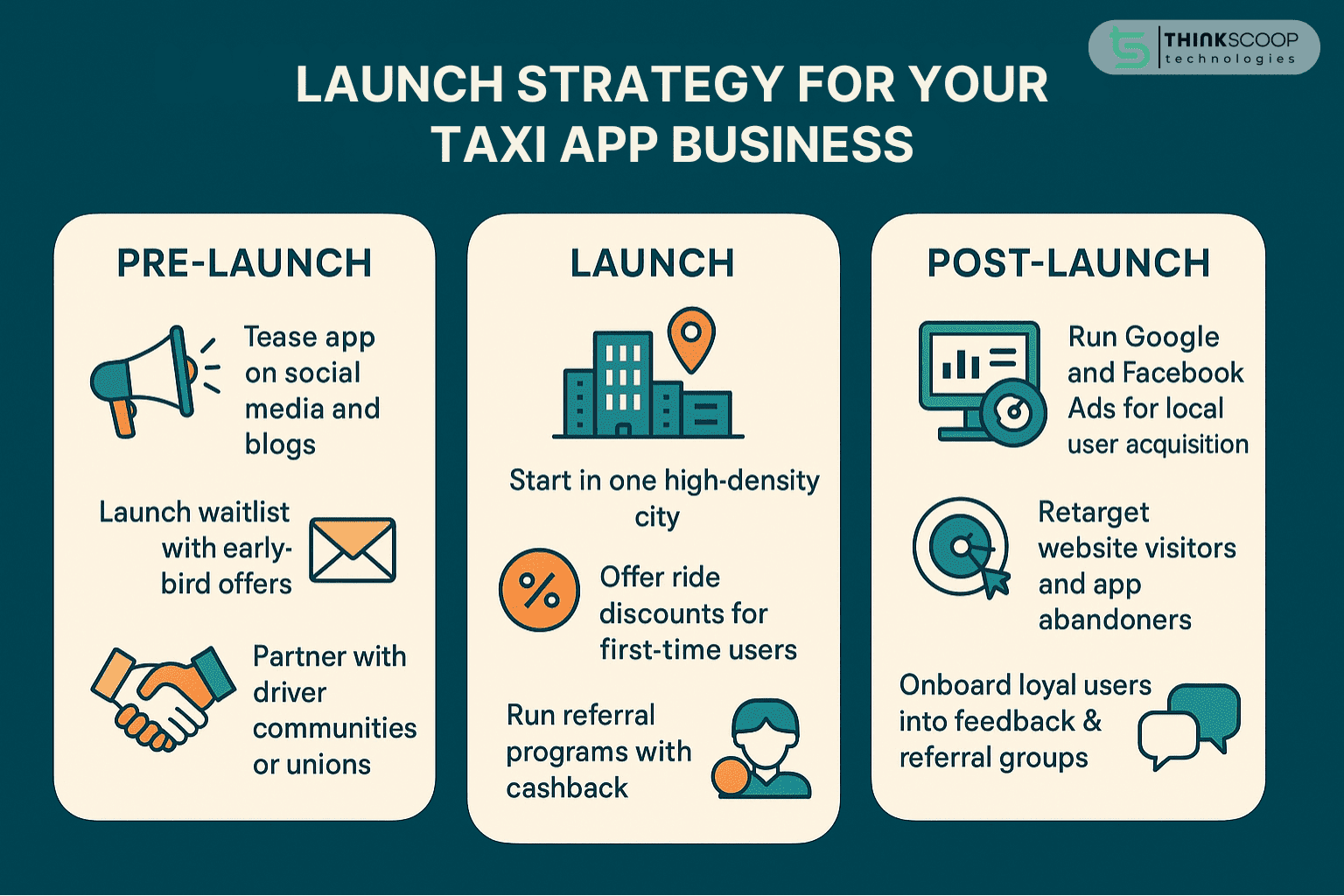
A strong product is only half the battle. Go-to-market execution defines success.
Pre-Launch:
- Tease your app on social media and blogs
- Launch a waitlist with early-bird offers
- Partner with driver communities and local transport unions
Launch:
- Start in one city with high user density
- Offer ride discounts for first-time users
- Run referral programs with cashbacks
- Collaborate with influencers & local businesses
Post-Launch:
- Use Google Ads, Facebook Ads for geo-targeted user acquisition
- Retarget website visitors and cart abandoners
- Onboard loyal users into feedback and referral groups
9. What to Track Post-Launch
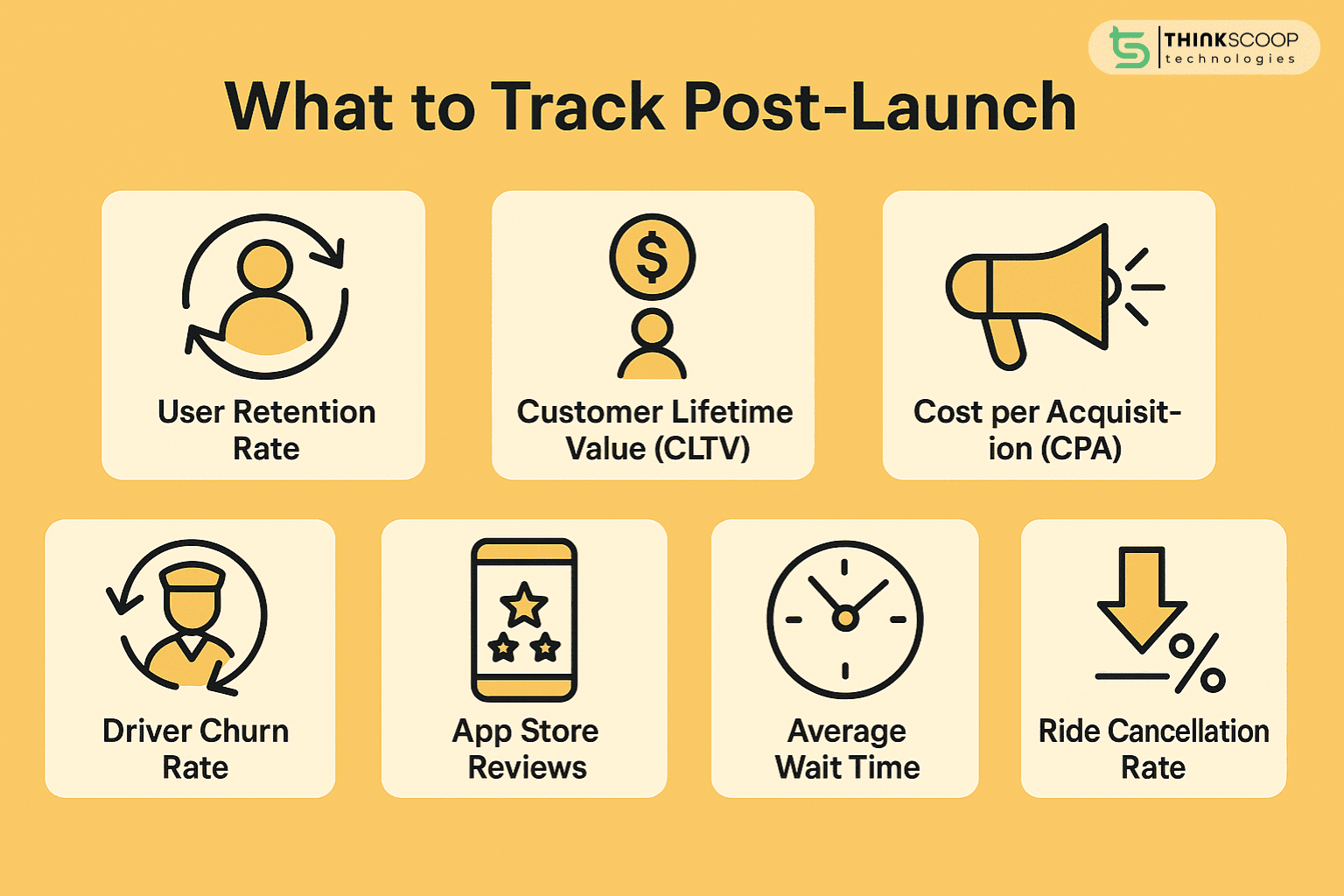
Ongoing success is driven by data and iteration.
- User Retention Rate
- Customer Lifetime Value (CLTV)
- Cost per Acquisition (CPA)
- Driver Churn Rate
- App Store Reviews
- Average Wait Time
- Ride Cancellation Rate
Use tools like Mixpanel, Amplitude, Firebase, and Hotjar for analysis.
10. Challenges to Prepare For
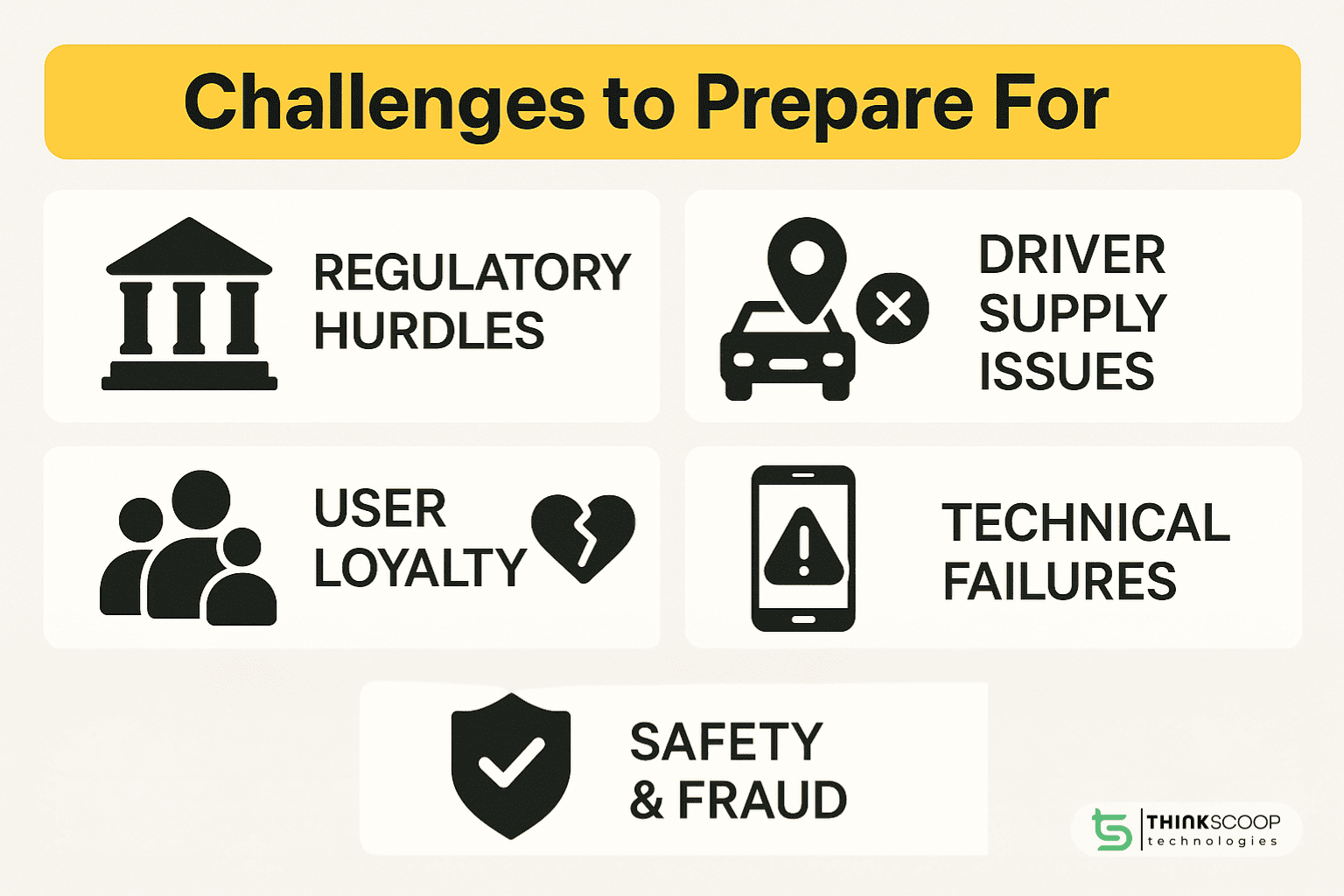
Launching a taxi app business isn’t without its obstacles.
- Regulatory Hurdles: City-level transport rules can be a maze.
- Driver Supply Issues: Getting a reliable fleet in new cities is tough.
- User Loyalty: Competing against giants means offering superior service.
- Technical Failures: Downtime during peak hours kills trust.
- Safety & Fraud: Both rider and driver verification must be airtight.
11. Uber Clone vs Building from Scratch: What’s Better?
| Criteria | Uber Clone | Custom App |
| Time-to-Market | 3–4 weeks | 12–14 weeks |
| Initial Cost | $10K–$20K | $30K–$60K |
| Feature Flexibility | Limited | Full customization |
| Branding Freedom | Restricted | Complete control |
| Ideal For | MVPs, pilot programs | Scalable business plans |
Choose a clone for rapid testing or MVPs, and custom builds for long-term, brand-heavy ambitions.
Final Thoughts
Starting a taxi app business in 2025 is a high-potential venture—but success lies in execution. Understand your users, build a reliable and feature-rich app, and focus on market-specific positioning. Whether you go with a ready-made Uber clone or develop a fully custom solution, your business can capture a significant share of this booming industry.
ThinkScoop can help you bring your taxi app idea to life. From AI-powered dispatch to clean UI and scalable backend systems, we offer both white-label and custom app development options tailored to your goals.
Ready to disrupt the mobility space? Let’s build your Uber-like app together.
Frequently Asked Questions (FAQs)
Q1. How much does it cost to start a taxi app business like Uber?
A: It typically ranges between $30,000–$60,000 depending on features, platforms, and regions.
Q2. Can I start a taxi app without owning vehicles?
A: Yes, the aggregator model lets you onboard independent drivers with minimal overhead.
Q3. How long does it take to build a taxi app?
A: A full-fledged taxi app can take 12–14 weeks from design to deployment.
Q4. What technology is required for real-time tracking?
A: GPS APIs, WebSockets (Socket.IO), and Firebase are essential for real-time location sharing and ETA updates.
Q5. How can I compete with Uber in my city?
A: Focus on hyperlocal branding, better customer support, reduced driver commissions, and niche features like electric vehicles or women-only rides.

